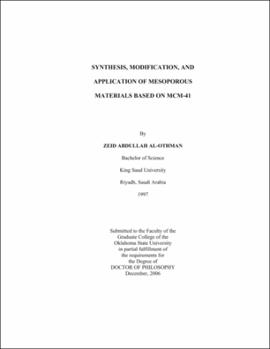| dc.contributor.advisor | Apblett, Allen W. | |
| dc.contributor.author | AL-Othman, Zeid Abdullah | |
| dc.date.accessioned | 2013-11-26T08:21:23Z | |
| dc.date.available | 2013-11-26T08:21:23Z | |
| dc.date.issued | 2006-12 | |
| dc.identifier.uri | https://hdl.handle.net/11244/6441 | |
| dc.description.abstract | Scope and Method of Study: The purpose of the investigation carried out in this research work was to synthesize mesoporous materials based on MCM-41 with high surface areas, large pore sizes, narrow pore size distributions, and high thermal, hydrothermal, and mechanical stabilities. This was completed by following the same procedures reported for the fabrication of the MCM-41 but with alterations in the surfactants and the additives used, and the reaction conditions employed such as the pH, the temperature, and aging time. Moreover, we aimed to modify these synthesized mesoporous materials with different functional groups of interest and evaluate their abilities in adsorption and separation of transition and heavy metal ions, and radioactive materials from aqueous medium. The functionalization of these mesoporous materials was done using different methods in order to maximize the number of groups on the surface and inside the pores. Different techniques such as infrared (IR), solid-state ^29Si and ^13C nuclear magnetic resonance (NMR), X-ray powder diffraction (XRD), thermal gravimetric analyses (TGA), and scanning and transmission electron microscopes (SEM and TEM) were used to confirm the production of the desired products. The surface area, pore size and pore size distribution were determined using the surface area analysis (BET) method. The surface properties (e.g., number of groups on the surface) of these materials were determined by the adsorption of a proper probing molecule. The adsorption and separation abilities of these modified materials for the transition and heavy metal ions, and radioactive materials in aqueous solution were performed in the pH range from 2 to 8 at room temperature. The equilibrium concentration of the metal ions were determined using lead analysis test kit for the lead and using ultraviolet-visible (UV-Vis), inductive couple plasma (ICP), and atomic absorption spectroscopy (AAS) for the rest of materials. | |
| dc.description.abstract | Findings and Conclusions: The synthesized mesoporous materials possess high surface areas, large pore sizes, narrow pore size distributions, and high thermal, hydrothermal, and mechanical stabilities. The modified mesoporous materials were found to have high selectivity and capacity in the adsorption and separation of the transition and heavy metal ions in the aqueous solution. In addition, they showed great selectivity and capacity for the adsorption and separation of the radioactive materials in aqueous medium. | |
| dc.format | application/pdf | |
| dc.language | en_US | |
| dc.rights | Copyright is held by the author who has granted the Oklahoma State University Library the non-exclusive right to share this material in its institutional repository. Contact Digital Library Services at lib-dls@okstate.edu or 405-744-9161 for the permission policy on the use, reproduction or distribution of this material. | |
| dc.title | Synthesis, modification, and application of mesoporous materials based on MCM-41 | |
| dc.contributor.committeeMember | Berlin, K. Darrell | |
| dc.contributor.committeeMember | Purdie, Neil | |
| dc.contributor.committeeMember | Foutch, Gary | |
| osu.filename | Al-Othman_okstate_0664D_1989.pdf | |
| osu.accesstype | Open Access | |
| dc.type.genre | Dissertation | |
| dc.type.material | Text | |
| thesis.degree.discipline | Chemistry | |
| thesis.degree.grantor | Oklahoma State University | |
